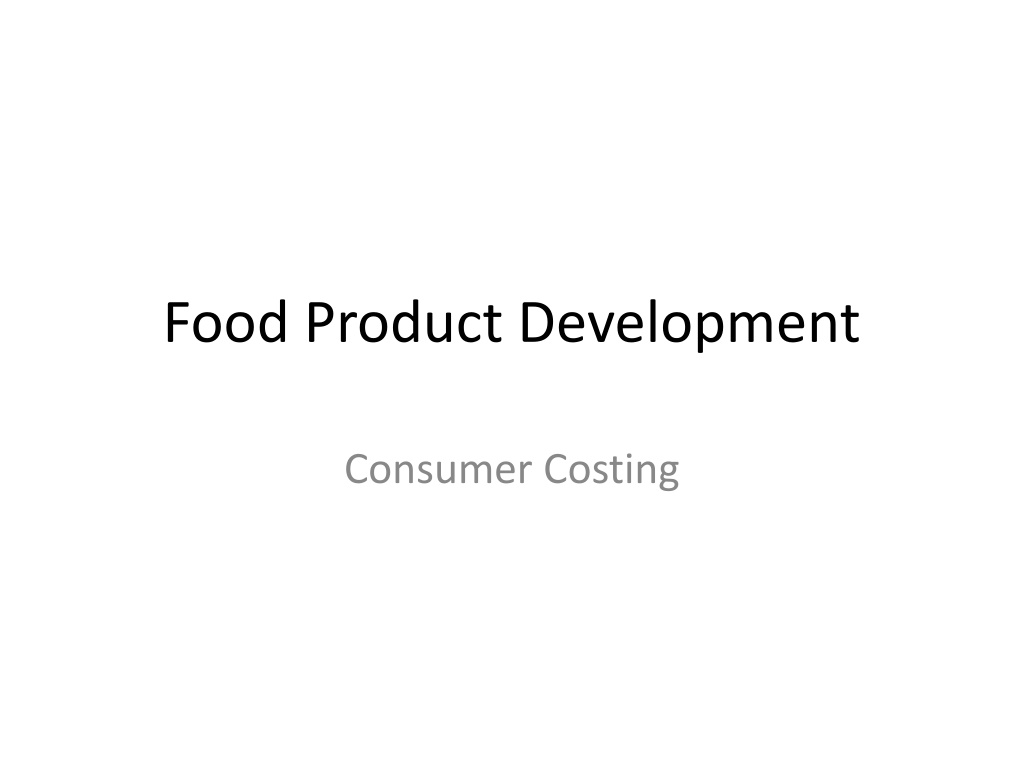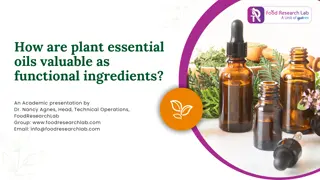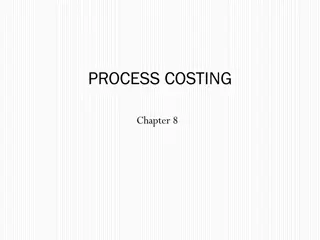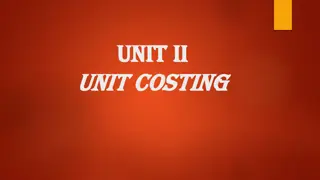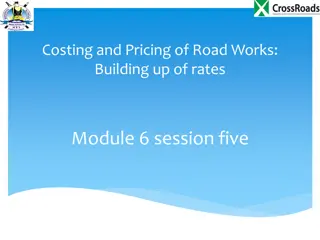Understanding Food Product Development and Costing
Explore the intricacies of cost management in food product development, including factors affecting costing, ways to reduce cost prices, and the impact on profit margins. Learn about key components of costing such as raw materials, testing, packaging, transportation, and marketing. Discover the differences between cost price, selling price, and food cost, and strategies for optimizing profitability by reducing costs without compromising quality.
Download Presentation

Please find below an Image/Link to download the presentation.
The content on the website is provided AS IS for your information and personal use only. It may not be sold, licensed, or shared on other websites without obtaining consent from the author. Download presentation by click this link. If you encounter any issues during the download, it is possible that the publisher has removed the file from their server.
E N D
Presentation Transcript
Food Product Development Consumer Costing
Topics Costing of food products Profit or gain? Reducing cost price Effects of reducing cost price Ways to manage cost price 2
Costing of Food Products Costing is an important part of the development process. During development, the product is refined through trialling and testing, and sensory evaluation, until a desired outcome is achieved. As the product is modified or changed, its cost is changed due to alteration in type and amount of ingredients used. Costings can be calculated using spreadsheets. 3
Costing of Food Products Raw materials Testing, research and development Specialised machinery Overheads (fuel, lighting, heating, cooling, equipment depreciation, salaries) Costing of food products Inner and outer packaging Transportation and distribution Advertising and marketing Profit 4
Profit or Gain? Cost Price (CP): The price at which an article is produced, is called its cost price. Selling Price (SP): Price at which an article is purchased is known as its selling price. Food cost: The price at which food ingredients are purchased, is called food cost. 5
Profit or Loss? Selling Price Cost Price Positive number SP CP Gain a profit 6
Profit or Loss? Selling Price Cost Price Negative number SP CP Lose money 7
Reducing Cost Price Examples of reducing food cost by: making slightly smaller portions, e.g. reduce the thickness of beef patties in hamburgers reduce the amount of cheese in cheese buns changing an expensive ingredient to a cheaper one, e.g. substitute meat with vegetables increase the carbohydrate content (e.g. rice) and reduce the protein content (e.g. meat) of the product mixing meat with an alternative protein food, e.g. add textured vegetable protein (TVP) in meat balls using flavourings and colourings instead of fresh ingredients , e.g. use fruit-flavoured drink instead of drink made from fresh fruits using bulking agent, e.g. add extra water in soup add starch into meat loaf (at the same time, using egg as binding agent to bind starch and meat) 8
Reducing Cost Price Examples of reducing packaging cost by: using cheaper packaging materials, e.g. use a paper box for cookies instead of a tin use practical meal box packaging instead of a fancy one using less packaging, e.g. avoid using outer packaging if inner packaging is available avoid using extra paper girdle if product information can be printed on packaging Examples of reducing transportation cost by: producing concentrated liquid food, e.g. add water to reconstitute the juice concentrate at consumers end to avoid transporting of water using Tetra Pak food packaging, e.g. use rectangular packaging for liquid food such as evaporated milk, instead of a cylindrical can, will save space in transportation vehicle, hence reducing the transportation cost 9
Effects of Reducing Cost Price Portion size Smaller portion size will induce more number of products, hence production planning should be done carefully to prevent overproduction Nutritional content Altering ingredients, using food additives, and reducing portion size will all affect nutritional content, therefore nutrient analysis should be performed each time after modification of formula Customer satisfaction Sensory evaluation should be conducted again to strike a balance between customer satisfaction and modifying the product to save food cost 10
Ways to Manage Cost Price Track food prices select suppliers who offer a bigger discount bulk purchase to increase bargaining power Inventory control keep the stock in good order to prevent loss from spoilage and pest infestation Production planning plan ahead, avoid overproduction and underproduction follow pre-determined recipes Manage wastage trim food properly recycle materials, if possible 11
References Fehners, V., Simpson, M., & Monks, B. (2011). Food technology. London: Hodder Education. Winson, A. (2003). Revise for OCR GCSE food technology. Oxford: Heinemann. 12
